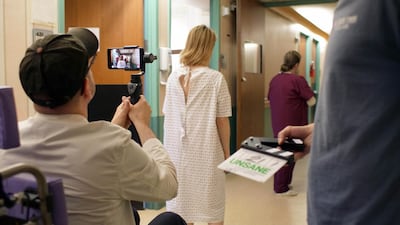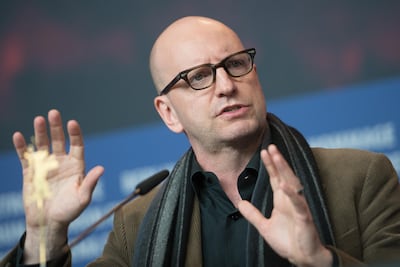If there's a sense that Steven Soderbergh has come full circle with his latest film, Unsane, it's understandable. This psychological thriller cost US$1.2 million – the budget of sex, lies and videotape, he says. Now nearing its 30th anniversary, Soderbergh's Dh4.4m 1989 debut was a sensation at Sundance, won him the Palme d'Or in Cannes and launched the unknown into the stratosphere.
Since then, he has won a Best Director Oscar for Traffic, directed the all-star Ocean's caper trilogy and, most recently, enjoyed a four-year hiatus from filmmaking to take up painting. With all that in mind, some filmmakers might consider it a failure if, after three decades, they're back making a movie for the same price that their debut cost. But the 55-year-old Louisiana native works differently to most.
Set in a mental asylum and starring The Crown's Claire Foy, Unsane was shot on a regular iPhone 7 Plus. With its in-built 4K camera, it's a pocket-sized device capable of producing big-screen images. "It was really exciting," Soderbergh says. "The positive aspects of it far outweighed for me the few things that you can't do. Or that you probably could do if you took more time, but I didn't have a lot of time."
He's not the first to try this – Sean Baker's 2015 film Tangerine used the iPhone 5 to tell a fizzy tale of Los Angeles street hustlers – but Soderbergh's work will certainly give encouragement to others. In an age when movies are becoming increasingly expensive, making it difficult for first-time filmmakers to get their start, Soderbergh has found the perfect way to shrink the economics of a production.
“There’s certainly an impact in the speed [of a film shoot]. You can do more work in a certain amount of time,” he says. Personnel are also reduced. “We had a really, really small crew. The camera department was the assistant cameraman and the camera package fit – all of it – in a backpack. So there’s a very tangible effect when you’re travelling that light, in terms of doing things and moving from this location to that location.”
It's typical of his desire for experimentation with the business models of filmmaking. His 2005 movie Bubble infuriated many in the industry when it was released simultaneously in theatres, on DVD and cable, something that's now quite common.
"If something is possible, you know somebody is going to do it," he says. "And so I guess my attitude then was, 'This is going to happen. It's possible. So why don't we start this process of exploration?'" Of course, Unsane wouldn't work half as well without an electric script from Jonathan Bernstein and James Greer.
The project started after Greer contacted Soderbergh, who asked him to write a horror. The two had worked on two unrealised projects – a Cleopatra musical (for Catherine Zeta-Jones) and an adaptation of John Barth's novel, The Sot-Weed Factor.
"We've spent enough time in a room talking that Jim knows what kind of movie that I'm going to respond to," says Soderbergh. "If he shows up with something that's really violent and has a lot of questionable, gratuitous activity in it, I'm probably not going to respond. I think he was smart enough to know the more this is like Repulsion, the better the shot that I'm going to respond."
Certainly, Roman Polanski's 1965 psychological horror, which starred Catherine Deneuve as a woman on the verge of a nervous breakdown, factors into Unsane. Foy plays Sawyer Valentini, a bank worker who escapes to Boston after a wretched time with a stalker (Joshua Leonard) on her case. But after a therapy session goes awry, she unwittingly commits herself to a 24-hour stay in a psych ward, leading her into a Kafka-esque nightmare.
Soderbergh spent the first half of 2017 working his way through a long list of asylum movies, like One Flew over the Cuckoo's Nest and Shock Corridor, in search of inspiration. "I'm looking at things to try and figure out what I want to steal," he says with a grin. But there nobody could accuse him of plagiarism: Unsane feels fresh. Like much of his finest work – his madcap linguistic comedy Schizopolis, his non-linear crime film The Limey – Soderbergh's at his best when he's breaking the rules.
With no phone-related glitches or breakdowns during the making of Unsane, it's been a success. Soderbergh's working on his second iPhone movie, High Flying Bird, starring André Holland, who starred in his TV hospital drama The Knick. But he's not expecting every director to abandon the large-scale apparatus that comes with most filmmaking. "Some people can't wrap their mind around doing a $20m film and shooting it on a phone that costs $700. That's a real obstacle." Obstacles? He thrives on them.
Unsane opens on Thursday across the country
___________________
Read more:
'We're going to show typical Hollywood movies': Black Panther to screen in Saudi Arabia tonight
Steven Spielberg joins the DC Universe with Blackhawk film
Palme d'Or: The films to watch at Cannes 2018
___________________


